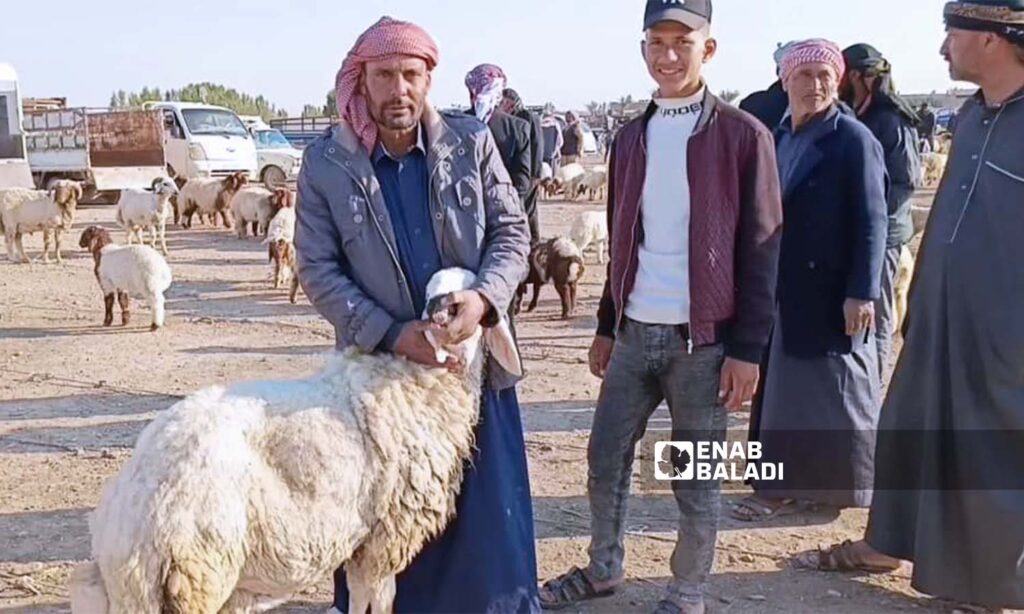With the arrival of May each year, the shearing of sheep’s wool begins in various breeding areas across Syria, and the term used for this shearing process in the rural areas of Qamishli is known as “al-Jalamah”.
The season usually starts as summer approaches and temperatures rise, to ensure the health of the sheep and to get rid of the excess wool that could cause them health problems.
Preparations begin three days before the shearing by washing the sheep and cleaning them of the dirt accumulated over the winter, waiting for the wool to dry completely to facilitate the shearing process.
Traditional rituals
Mohammed Masoud, a livestock breeder in the village of Tel Maarouf in the countryside of Qamishli city, told Enab Baladi that he and other breeders in the area practice traditional rituals associated with the shearing season.
Masoud collects the wool after shearing for investment, distribution, or home use as an alternative to carpets in winter, and it may be destroyed due to low market demand.
According to Masoud, these habits and traditions followed by him and other breeders are an important part of their cultural heritage and are passed down through generations.
These rituals are essential to maintain the health of the sheep and ensure the quality of the wool.
Mouhsen Abdel Jalil, another livestock breeder, explained to Enab Baladi how to perform the traditional shearing process.
Special scissors are used for the task, and the animal’s legs are tied to restrict its movement and facilitate the shearing process.
Abdel Jalil emphasized the importance of care and skill in shearing to avoid harming the animal, especially around sensitive areas such as the belly and udder.
He mentioned that preparations include readying iodine dye, alcohol solutions, and special sprays beforehand to ensure their availability when needed and to help heal any wounds that occur during shearing.
These steps and preparations reflect the breeders’ commitment to the health and comfort of the animals and the quality of the resulting wool.
According to Abdel Jalil, the collection of wool was historically a competitive activity among locals, and the wool was used in making carpets, covers, and many other household necessities. However, there has been a decline in interest in recent times due to the emergence of ready-made furnishings and other alternatives.
Health benefits for sheep
Shearing wool has several benefits for sheep, as mentioned by the veterinarian Ahmad Askar in his conversation with Enab Baladi.
The doctor noted that shearing reduces the incidence of skin diseases in sheep and helps in removing dirt and external parasites such as lice and ticks that may gather under the wool, thus reducing the spread of diseases and maintaining the health of the animals.
Additionally, the shearing process helps reduce the body temperature of the animals and allows their skin to cool, making them feel more comfortable and refreshed.
This process also allows for the renewal of the sheep’s wool, contributing to its improved quality and durability.
Askar also pointed out that wool shearing facilitates healthcare for sheep, as breeders can easily clean and monitor the health of the animals after shearing, providing an opportunity to detect any health problems early and apply the necessary treatment.
Livestock breeders in Syria are facing multiple difficult conditions, pushing many of them to consider abandoning the profession, whether or not alternatives exist, compelling them to sell their livestock if buyers are available, or to slaughter them to alleviate the burden of their costs.
Before 2011, livestock were responsible for about 40% of total agricultural output in Syria, also providing employment for approximately 20% of the workforce in rural areas, according to a study by the international organization “IMMAP,” published in May 2021.
Approximately 35% of rural households in Syria considered livestock breeding their primary source of food and income.
Mohammad al-Abdullah, an economic researcher at the Omran Center for Strategic Studies, previously told Enab Baladi that one of the main reasons for the decline in livestock wealth is the unsuitability of the local environment sustaining this sector in a country embroiled in conflict since 2011.
He added that other factors have also impacted the sustainability of supporting the livestock sector, including a significant reduction in grazing areas, large numbers of livestock deaths due to disease outbreaks, rising prices of veterinary medicines, and high feed costs, in addition to the common practice of smuggling livestock to neighboring areas and countries for profit.

